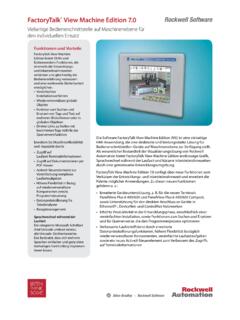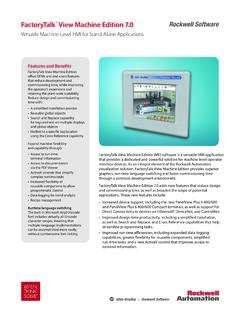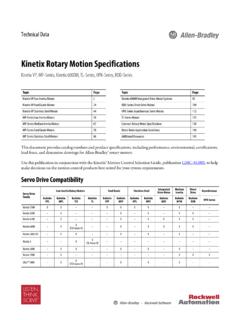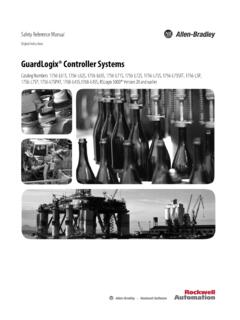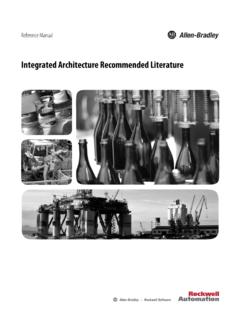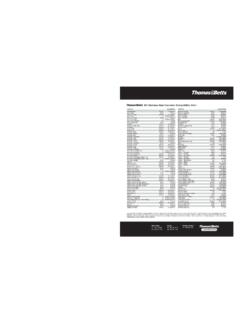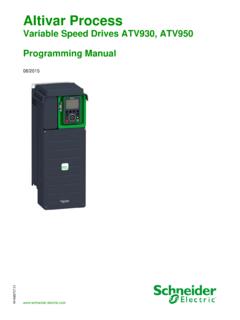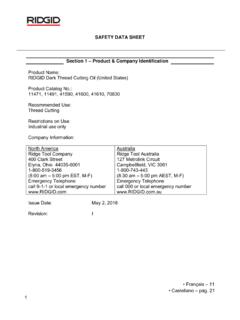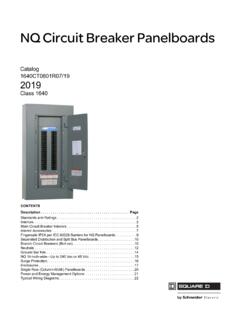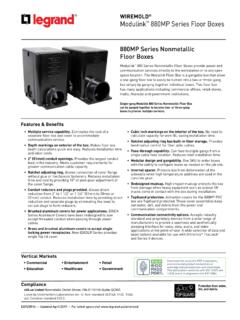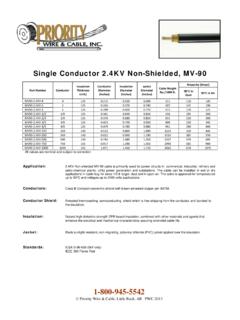Transcription of Power Cable Splicing and Terminating Guide
1 Power Cable Splicing and Terminating GuideQuality Workmanship that Lasts2 Innovative solutions, technology and reliability are vital to your business. To be successful, you depend on both quality products and effective installations. That s why the contributions of 3M scientists and engineers extend beyond developing products to sharing best practices on how to use them. With a solid understanding of your industry and the technology that drives it, we strive to help make your work easier and more the pages to discover Cable Splicing and termination techniques that can help reduce the risk of errors that could causepremature electrical failures and help make you look like a of ContentsThe Technology ..4 The Human Factor ..5 Medium/High Voltage Power ..6 Components ..7 conductor ..7 Concentric Stranding ..7 Compressed Stranding.
2 7 Compact Stranding ..7 Solid Wire ..7 Strand Shielding ..8 Insulation ..8 Insulation Shield System ..9 Jacket ..9 Preparation ..10 Abrasives ..11 Solvents ..11 Splicing ..12 Definition ..12 Steps ..13 Prepare Surface ..13 Join Conductors With Connector(s) ..18 Stress Control ..20 Geometric ..22 Capacitive ..23 External Leakage Insulation ..24 Seal to the External Environment ..264 The TechnologyRubber TechnologyOur cold shrink tubing is engineered from strong, adaptable rubber that installs easily and fits securely around splices and Technology Our full line of high-performing connectors are UL Listed for many crimping tools to provide a reliable connection and improve installer Technology Our liquid resins provide an extra layer of insulation that protects electrical components and assemblies from natural Technology Our durable tapes are designed with various materials to insulate across a wide range of electrical are only as good as the people who create them.
3 Teams of 3M scientists, chemists, engineers, electricians and technicians work together with manufacturing, quality control, sales and distribution to deliver high quality products products that resolve complex problems and are easy to s why 3M products include human engineering. Not only are our products long-lasting and cost effective but they also work smoothly and efficiently in installers hands. Human engineering combines the human factor with technology, developing products that work for Human Factor6 Medium/High Voltage Power CableJacketMetallic ShieldInsulationConductorStrand ShieldingSemi-conductorMedium/High Voltage Cable Types Of the nearly limitless variety of cables in use today, five of the most common are: Tape shielded Drain wire shielded General Cable UniShield Concentric Neutral (CN) Jacketed Concentric Neutral (JCN)Beyond Cable shield types, two common configurations are used: single conductor - consisting of one conductor per Cable or three cables for a three-phase system.
4 Three conductor - consisting of three cables sharing a common these visible differences, all Power cables are essentially the same, consisting of: conductor Strand shield Insulation Insulation shield system (semi-conductive and metallic) JacketEach component is vital to an optimally performing Power Cable and must be understood in order to make a dependable splice or Voltage Cable ComponentsConductorThe current carrying components are made of copper or aluminum. (Aluminum is less expensive but less efficient, requiring a larger conductor diameter to carry an equal electrical load when compared to a copper conductor .)Conductors used with modern solid dielectric cables come in four basic configurations:Concentric Stranding(Class B)Concentric stranding is not commonly used in modern shielded Power cables. The penetration of the extruded strand shielding between the conductor strands makes the strand shield difficult to remove during field Cable preparation.
5 Compressed StrandingCompressed stranding is a commonly used conductor configuration. Compressed to 97 percent of concentric conductor diameters, the compressed strands block the penetration of an extruded strand shield, making it easily removable in the field. For sizing lugs and connectors, the sizes remain the same as with the concentric StrandingCompacted to 90 percent of concentric conductor diameters, the reduced conductor size results in all of the Cable s layers being proportionally reduced in a diameter, an important consideration when sizing for molded rubber products. Although this conductor has full ampacity ratings, the general rule for sizing is to consider it one conductor size smaller than concentric or WireThis conductor is not commonly used in industrial shielded Power ShieldingStrand shielding is the semi-conductive layer between conductor and insulation, which compensates for air voids that exist between conductor and is a poor insulator, having a nominal dielectric strength of only 76 volts per mil, while most Cable insulation have dielectric strengths over 700 volts per mil.
6 Without strand shielding, an electrical potential exists that will over-stress these air air breaks down or ionizes, it goes into corona (partial discharges). This forms ozone, which chemically deteriorates Cable insulation. The semi-conductive strand shielding eliminates this potential by simply shorting out the cables are generally constructed with an extruded strand shield.(Reference: AEIC NO. 5, D. Semi-conducting Shielding.)InsulationA third layer consisting of many different variations such as extruded solid dielectric or laminar (oil paper or varnish cambric). Its function is to contain the voltage within the Cable system. The most common solid dielectric insulations in industrial use today are: Cross-linked polyethylene (XLP) Ethylene propylene rubber (EPR) PolyethyleneEach is preferred for different properties such as superior strength, flexibility, temperature resistance, etc.
7 , depending upon the Cable characteristics required. The selection of the Cable insulation level to be used in a particular installation shall be made on the basis of the applicable phase-to-phase voltage and the general system category as outlined percent Level - Cables in this category may be applied where the system is provided with relay protection such that ground faults will be cleared as rapidly as possible, but in any case within one minute. These cables are applicable to the great majority of the Cable installations, which are on grounded systems. They may be used also on other systems for which the application of Cable is acceptable, provided the above clearing requirements are met in completely deenergizing the faulted percent Level - This insulation level corresponds to that formerly designated for ungrounded systems.
8 Cables in this category may be applied in situations where the clearing time requirements of the 100 percent level category cannot be met, and yet there is adequate assurance that the faulted section will be de-energized in a time not exceeding one hour. Also, they may be used when additional insulation strength over the 100 percent level category is percent Level - Cables in this category should be applied on systems where the time required to de-energize a grounded section is indefinite. Their use is recommended also for resonant grounded systems. Consult the manufacturer for insulation ShieldingInsulationFigure 2 Figure 3 Figure 19 Non-shieldedCableElectric Flux LinesHigh StressConcentrationEven StressDistributionSemi-ConductorMetallic ShieldingJacketInsulation Shield SystemThe outer shielding which is comprised of two conductive components: a semi-conductive layer (semi-con) under a metallic layer.
9 (See Cable types for common shield varieties.) The principal functions of the insulation shield system are to: Confine the dielectric field within the Cable Obtain a symmetrical radial distribution of voltage stress within the dielectric Protect the Cable from induced potentials Limit radio interference Reduce the hazard of shock Provide a ground path for leakage and fault currentsThe shield must be grounded for the Cable to perform these semi-conductive component is available either as a tape or as an extruded layer. (Some cables have an additional layer painted between the semi-con and the Cable insulation.) Its function is similar to strand shielding: to eliminate the problem of air voids between the insulation and metallic component (in this case, the metallic shielding). In effect, it shorts out the air that underlies the metallic shield, preventing corona and its resultant ozone metallic shield is the current carrying component that allows the insulation shield system to perform the functions mentioned earlier.
10 This is the layer where various Cable types differ most. For that reason, most cables are named after their metallic shield ( , tape shielded , drain wire shielded , UniShield , etc.).As a result, shield type ( Cable identification) becomes important information to know when selecting products for Splicing and jacket is the tough outer covering for mechanical protection as well as moisture barrier. Often, the jacket serves as both an outer covering and the semi-conductive component of the insulation shield system, combining two Cable layers into one: the semi-conductive jacket. Typical materials used for Cable jackets are PVC, neoprene, lead, etc. Frequently, industrial three conductor cables have additional protection in the form of an armor 4 Figure 5 Figure 610 Medium/High Voltage Cable PreparationIt is necessary to begin with a good Cable end.
